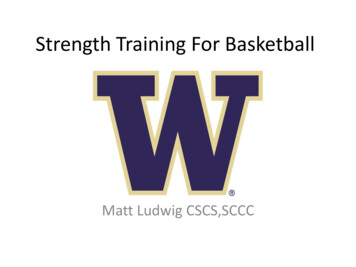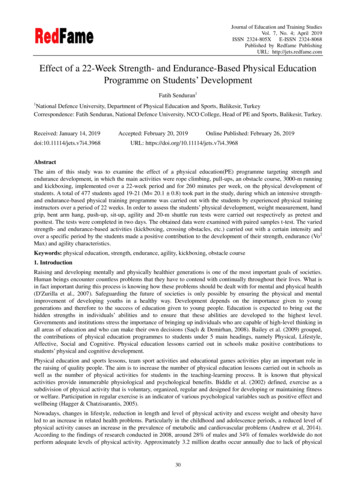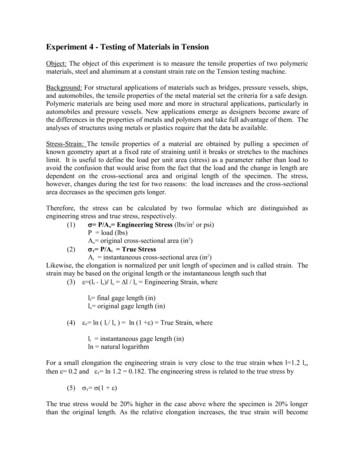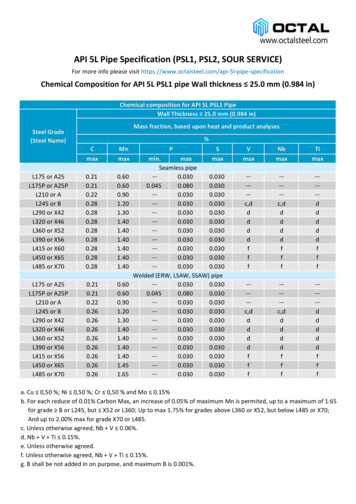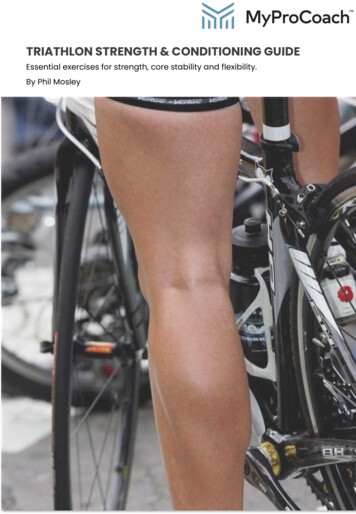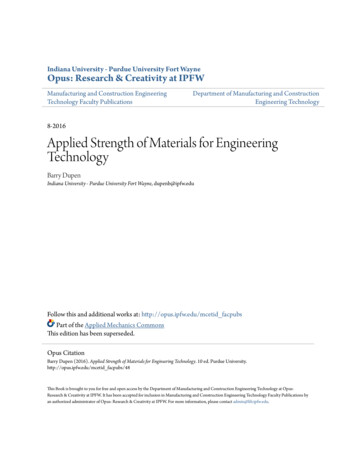
Transcription
Indiana University - Purdue University Fort WayneOpus: Research & Creativity at IPFWManufacturing and Construction EngineeringTechnology Faculty PublicationsDepartment of Manufacturing and ConstructionEngineering Technology8-2016Applied Strength of Materials for EngineeringTechnologyBarry DupenIndiana University - Purdue University Fort Wayne, dupenb@ipfw.eduFollow this and additional works at: http://opus.ipfw.edu/mcetid facpubsPart of the Applied Mechanics CommonsThis edition has been superseded.Opus CitationBarry Dupen (2016). Applied Strength of Materials for Engineering Technology. 10 ed. Purdue University.http://opus.ipfw.edu/mcetid facpubs/48This Book is brought to you for free and open access by the Department of Manufacturing and Construction Engineering Technology at Opus:Research & Creativity at IPFW. It has been accepted for inclusion in Manufacturing and Construction Engineering Technology Faculty Publications byan authorized administrator of Opus: Research & Creativity at IPFW. For more information, please contact admin@lib.ipfw.edu.
Applied Strength of Materials forEngineering TechnologyBarry DupenAssociate Professor, Mechanical Engineering Technology, Indiana University – Purdue University Fort Waynev.10 Revised August 2016. This work is licensed under Creative Commons Attribution-ShareAlike 4.0International (CC BY-SA 4.0) See creativecommons.org for license details.1
Table of ContentsPreface.3Purpose of the Book.3Editors.4Cover Photos.5Terminology.6Definitions.9Chapter 1: Introduction to Strength of Materials.11What is Strength of Materials?.11The Factor-Label Method of Unit Conversion.12Chapter 2: Stress and Strain.17Normal Stress and Strain.17Sign Convention.19Shear Stress and Strain.20Chapter 3: Poisson's Ratio and Thermal Expansion.23Poisson's Ratio.23Thermal Expansion and Thermal Stress.25Chapter 4: Pressure Vessels and Stress Concentrations.28Thin-Walled Pressure Vessels.28Stress Concentration in Tension.30Chapter 5: Bolted and Welded Joints.33Bolted Lap Joints Loaded in Tension.33Welded Lap Joints.38Chapter 6: Properties of Areas.41Dimensions and Area.41Centroid and Centroidal Axes.41Moment of Inertia of a Rectangle.41Compound Beams Sharing a Centroidal Axis.42Hollow Beams Sharing a Centroidal Axis.43The Transfer Formula.44Compound Beams With Different Neutral Axes.45Hollow Beams With Different Neutral Axes.48Moment of Inertia about the y-y Neutral Axis.51Shortcuts.54Radius of Gyration.54Polar Moment of Inertia.54Chapter 7: Torsion in Round Shafts.55Shear Stress in a Round Shaft.55Angle of Twist in a Round Shaft.57Stress Concentration in Torsion.58Chapter 8: Beam Reactions, Shear Diagrams, and MomentDiagrams.60Loads on Beams.60Reactions for Simply-Supported Simple Beams.61Reactions for Overhanging and Cantilever Beams.64Shear Diagrams.66Moment Diagrams.72Chapter 9: Stresses in Beams.82Bending Stress in Beams.82Bending Stress in Wide-Flange Steel Beams.84Shear Stress in Beams.87Allowable Load.92Chapter 10: Beam Deflection.94Radius of Curvature.94The Formula Method for Simple Cases.95Formula Method Hints.98The Formula Method for Complex Cases: Superposition.98Visualizing the Deflection Curve.100Chapter 11: Beam Design.102Wide-Flange Steel Beam Design in Six Easy Steps.102Timber Beam Design in Six Easy Steps.108All Other Beams.110Chapter 12: Combined Stresses.112Tension Bending.112Bending in Two Directions.112Eccentric Loading.114Chapter 13: Statically Indeterminate Beams.118Defining Determinate and Indeterminate Beams.118Method of Superposition.118Chapter 14: Buckling of Columns.124Types of Columns.124Ideal Slender Columns.124Structural Steel Columns.126Steel Machine Parts.127Chapter 15: Visualizing Stress and Strain.130Measuring Stress.130Stress at the Base of a Short Block.130Mohr's Circle.131Bibliography.148Textbooks.148Other Reading Material.148Appendix A: Units.149SI System of Units.149US Customary System of Units.149Appendix B: Materials Properties.150Metals, Concrete, & Stone.150Appendix C: Properties of Areas.154Center of Gravity, Area, Moment of Inertia, and Radius ofGyration.154Appendix D: Properties of Steel Beams and Pipes.157W-beams.157Steel Pipes.161Copper Tubing.162Appendix E: Mechanical and Dimensional Properties of Wood.163Mechanical Properties of Air-Dried Boards and Timber.163Softwood Lumber and Timber Sizes.164Appendix F: Beam Equations.166Index.171Index.1712
PrefacePrefacePurpose of the Book1.9 million bachelors degrees are awarded annually in the US.1 About 92 thousand are Engineering degrees, and about 17thousand are Engineering Technology degrees and Technician degrees. The number of Mechanical, Civil, and ConstructionEngineering Technology graduates is only about 2 thousand per year, so the market for algebra-based Strength of Materialstextbooks for Engineering Technology is a small fraction of the market for calculus-based Engineering textbooks.Since I attended college in the 1980s, textbook prices have risen about twice as fast as inflation. The internet did not existback then, so all textbooks were printed. Now we have another option: low-cost or free online e-books which are revisedmore frequently than printed books. While traditional textbooks are revised every 4 to 10 years based on input from expertsin the topic, this e-book is revised every semester based on input from experts in learning: the students.Students complain that the explanations in many Engineering Technology textbooks are too theoretical, too wordy, and toodifficult to understand. They also complain about the lack of complete unit conversions in example problems, andinconsistent use of symbols between related courses. For example, some authors use sn, ss, and e for normal stress, shearstress, and strain, instead of the standard Greek symbols σ, τ, and ε. This use of Latin characters with multiple subscriptsconfuses students because the Greek symbols are used in other textbooks, and because capital S is used for section moduluslater in the course. Students have trouble distinguishing between s and S on the chalkboard and in their notes.Professors complain that too many students copy answers from online solution manuals or fraternity homework files insteadof learning to solve problems from scratch, then these students fail exams. Probably 10% of the learning in Strength ofMaterials occurs in class, and 90% occurs as students solve problems. Deliberately, the problem set for this book is notavailable online, and is changed every semester.I teach Strength of Materials to Mechanical and Construction Engineering Technology students. These students tell me theywant help with algebra skills, unit conversions, and problem-solving approaches. The problem set that accompanies thisbook contains problems requiring an algebraic answer as well as traditional problems requiring a numerical answer. TheFactor-Label Method of Unit Conversion is emphasized from the first chapter, and is used in all example problems.Summarizing, the goals of this book are: Free distribution over the internet Frequent revisions based on student input Concise explanations Examples with complete unit conversions Standard Greek symbols for stress and strain Problems requiring algebraic answers as well as problems requiring numerical answers Problems requiring answers in sentences to show reasoning and understanding of the topicsThis e-book is revised on an ongoing basis. Please send suggestions for improvement to me at dupenb@ipfw.edu.Barry DupenIndiana University – Purdue University Fort WayneFort Wayne, IndianaAugust, 20161Data from 2013-2014. Current numbers are in the Digest of Educational Statistics, published by the National Center for EducationalStatistics, U.S. Department of Education, at nces.ed.gov.3
PrefaceEditorsThese IPFW students edited the text and contributed to improving this book:Jacob AinsworthAaron AlexanderGeorge AllweinMatthew AmbergJared ArcherMark ArcherMark ArmstrongJustin ArnoldStuart AspyCaleb AverillAlex BaerTrenton BarnettRyan BaughmanJacob BeardNeil BeauchotMitchell BellamAaron BenderEmily BendixMaverick BirchKevin BlackJohn BlankenshipConnor BlekeJason BobayTyler BolingerDaniel BoneCrystal BoydValerie BrattenAaron BryantBrady BryantGregory BunnNicholas BurchellJustin ByerleyBlake CainDanny CalderonBrody CallaghanEsperanza CastilloRichard ChadwickTyler ChambersBrian ChaneyJacob ClasenZachary ClevengerRyan ClingenpeelMitchell ComparetUriel ContrerasJordan CookLogan CountermanStephen CoxDillon CraigChad CrosbyDaniel CummingsTayler CummingsBrian DaleyChristopher DavisPatrick DavisRoss DillionJoshua DunlapJared ElliottStephen EnglandCameron EymanJacob FalkJoshua FarleeChristopher FauroteTyler FaylorAustin FearnowBenjamin FiechterAlexander FisherJohn FisherMisael FloresCharles ForemanBryce ForresterCamden FoxDominick FrancoMichael FriddleNathan FryeJacob GaerteBrett GagnonJoseph GallmeyerMatthew GambleCarl GarringerShane GiddensAndrew GordonAlmario GreeneMichael GresleyRyan GuiffLucas HahnDavid HalpinCharles HanesAdam HanfordChristian HarmeyerBrian HarperJames HarrisSkyler HayesMatthew HauterAlexander HeineCody HeplerCameron HerringBen HinoraKaleb HerrickSpencer HilleTyler HinoraFrank HoffmanJames HoppesBradley HornDerick HostetlerJosef IferSujinda Jaisa-ArdAriana JarvisDaniel JohnsJason JoynerLucas KaiserJohn KeeneAdam KellingAdam KennedyJoseph KentHannah KininghamNate KipferPatrick KirkAndrew KitrushRachael KlopfensteinJoel KumferBranden LagassieKyle LagemannDoug LambertBrandon LaneJustin LantzTaylor LantzPatrick LaroyVenus LeeChristopher LeekDaniel LewisJonathan LewisPark LickliterEric LilesJoseph LortieAndrew LoughboroughJonah MackKyle MackeCullan MagnusonLinda MandukaAustin MannDalton MannDavid MarcAureleLucas MartinSterling MartinAlex MasonLa Keisha MasonJason MayesJacob MazurekJoel McBainAdam McCartyTori McGairkMichael McLindenRiley McMurrayJames McVickerAngela MendozaJedd MinnichKaitlin MooreDerek MorrealeSenaid MrzljakTravis MullendoreBlake NicolKyle NollMichael NusbaumMitchell OlneyJordan OwensJason PaceRyan PearceJacob PenlandNicholas PenrodLuis PereaTad PfefferkornJohn PhamClayton PhilipsJohn PogueGabe PowellBraxton PowersNathan PrattTrey ProperDakota RassmanJustin ReeseJames ReitzMatthew RejakJames RensbergerShawn ReuilleDaniel ReynoldsDaniel RiemanCharles RinehartJason RingerDerek RipleyMatthew RoellJennifer RoyerConnor RubyBrandon RudeAustin RumseyBillie SaalfrankZachary SaylorJohn SchaferZackory SchaeferRiley SchuetteZeke SchultzJustin SelfRyan SellersPhilip SheetsNathan ShenemanKeith ShepherdScott ShifflettBrad ShamoMatthew ShimkoKenneth ShortTrenton ShrockGeorge SiddonsTravis SingletaryEric ShortenShane SloneJacob SmarkerEllen SmithMatthew SomerlottJoshua SorgeMatthew SteinerJason StroleJonas SusarabaTroy SutterfieldRobert SwansonChristopher SwygartKyle TewZach ThornNathaniel TimmonsJason TonnerChandler TraceyCody TurnerJames UptonJason VachonThadius VeseyDakota VogelScott VorndranCharles WadsworthJay WehrleTravis WeigoldSam WeisserBrock WestergaardGrant WilsonKenneth WinScott WolfeMichael WoodcockLyndsay WrightMatthew YoungTang ZhongAdditional editing suggestions were provided by Neil Petroff, Visiting Assistant Professor at Purdue University SouthBend; Israr Ahmad of Dammam, Saudi Arabia; and Dr. Parviz Ghavami of Harlingen, Texas.4
PrefaceCover PhotosCover photos by the author. Geodesic greenhouses at The Eden Project, Bodelva, England (2000); barn ceiling at SomersetRural Life Museum, Glastonbury, England (14th century); interior of a tourist kiosk near Squamish, British Columbia; 8mile long Confederation Bridge between New Brunswick and Prince Edward Island (1997); interior of Fitch's coveredbridge, Delhi, New York (1870); Menai suspenion bridge, Menai Bridge, Wales (1826).This book was created with the Apache Software Foundation's Open Office software v. 4.1.25
TerminologyTerminologySymbols used in this book, with typical unitsBecause the Roman and Greek alphabets contain a finite number of letters, symbols are recycled and used for more than oneterm. Check the context of the equation to figure out what the unit means in that equation.Other science and engineering disciplines use different symbols for common terms. For example, P is used for point loadhere; in Physics classes, F is commonly used for point load. Some older Strength of Materials texts use µ for Poisson's ratio,s for stress, and e for strain; the formulas are the same, but the labels differ.SymbolαγγδΔΔεη jointνρστθA,aA'bcdddi ,dodHeEF.S.GhhIJKKlLLMTermU.S. UnitsSI UnitsThermal expansion coefficientShear strainSpecific weightChange in dimension (length, diameter, etc.)ChangeBeam deflectionStrainJoint efficiencyPoisson's ratioDensityNormal (perpendicular) stressShear (parallel) stressAngle of twistAreaTerm in the General Shear FormulaBase dimension of a rectangleTorsion problem: distance from centroid to outer surfaceBeam problem: distance from neutral axis to outer surfaceDiameterTransfer distanceInside and outside diameters of a pipeHole diameterEccentricityYoung's modulus (a.k.a. modulus of elasticity)Factor of safetyShear modulus (a.k.a. modulus of rigidity)Height dimension of a rectangleFillet weld throatMoment of inertiaPolar moment of inertiaStress concentration factorEffective length factor (in column analysis)Fillet weld legLength (of a tension member or a beam)Total weld lengthMoment F-1 lb./in.3, lb./ft.3in. in. % slug/ft.3psi, ksipsi, ksi(radians)in.2in.2in.in. C-1 N/m3mm mm % kg/m3MPaMPa(radians)mm2, m2mm2, m2mmmmin.in.in.in.in.psi, ksi psi, ksiin.in.in.4in.4 in.ft.in.lb. ft., kip ft.mmmmmmmmmmMPa MPammmmmm4mm4 mmmcmkN m6
TerminologySymbolnNNFpPP crPGPNPPPSP weldQrrGRRStTTVwWx, y, zxyyyzZDefnitionU.S. UnitsNumber of shear planes Number of bolts Number of holes in the fracture plane Fluid pressurepsi, ksiPoint loadlb., kipEuler critical buckling loadlb., kipBolt load – gross tensile failure of the platelb., kipBolt load – net tensile failure of the platelb., kipBolt load – bearing failure of the platelb., kipBolt load – bolt shear failurelb., kipWeld load (lapped plates loaded in tension)lb., kipTerm in the General Shear Formulain.3Radius (of a hole, fillet, or groove)in.Radius of gyrationin.Reaction forcelb., kipRadius of curvaturein., ft.Section modulusin.3Thicknessin.Torquelb. ft., kip ft.Temperature FShear loadlb., kipDistributed load (weight per unit length)lb./ft., kip/ft.Weightlb., kipAxes in three-dimensional space: x is horizontal, y is vertical, and z is into the page.Distance along the x-axisin., ft.Distance along the y-axis, such as the distance from thein., ft.neutral axis in beam problemsDistance from the reference axis to the x-x axis of ain.composite shape [moment of inertia problems]Term in the General Shear Formulain.Distance along the z-axisin., ft.Plastic section modulusin.37SI Units kPakNkNkNkNkNkNkNmm3mmmmkNmm, mmm3mmkN m CkNkN/mkN mm, mmm, mmmmmmm, mmm3
TerminologyGreek LettersUpper caseABΓΔEZHΘIKΛMLower aEpsilonZetaEtaThetaIotaKappaLambdaMuUpper caseΝΞOΠPΣTYΦXΨΩLower igmaTauUpsilonPhiChiPsiOmega
DefinitionsDefnitionsAllowable (stress, load, etc.).Permitted for safe design.Bending moment, M .Moment in a beam that is loaded in bending with transverse loads.Bending stress, σ .A normal stress along the length of a beam that develops due to transverse loading.Buckling.Collapse of a long, thin member under longitudinal compressive loading, at a loadmuch lower than the load that causes yielding in tension.Density, ρ .Mass density is the mass of an object or fluid divided by its volume. See specificweight entry for weight density.Distributed load, w .Force acting over a length (such as the weight of a beam) or area (such as a snow loadon a roof). Compare point load.Eccentricity, e .Distance between the neutral axis of a part and the location of an applied point load.Effective length of a column.Portion of the length of a column that bows like a fully pinned column.Elastic deformation.Temporary deformation; release the load and the part returns to its original shape.Compare plastic deformation.Elastic modulus, E .A measure of the stiffness of a material (the resistance to elastically deforming undera given load.) The slope of the linear elastic portion of the stress-strain curve. Alsocalled Young's modulus or modulus of elasticity.Euler critical buckling load, P cr .The load at which an ideal Euler column will fail, assuming perfect material andperfectly aligned loading.Factor of Safety, F.S.The material's strength (typically yield strength) divided by the actual stress in thepart. Also called “factor of ignorance” because it includes unknowns such asmaterials defects, improper installation, abuse by the operator, lack of maintenance,corrosion or rot, temperature variations, etc.Fillet weld.A weld with a triangular cross section used for joining lapped plates. Unlike solderingor brazing, welding involves melting the base metal as well as the joining material.Fracture plane.In a bolted joint that fails, fracture occurs through the bolt holes or through a plateaway from the bolt holes.the site of fracture is called the fracture plane.General shear formula.Equation for finding the shear stress within a beam of any shape.Joint efficiency.The efficiency of a bolted or welded joint is the lowest allowable load divided by theallowable load of the weaker of the two plates some distance from the joint.Longitudinal direction.Along the length of a part, such as a beam or shaft. Compare transverse direction.Longitudinal (axial) stress, σ .Normal stress that develops in a tensile or compressive member due to axial loading.Modulus of elasticity, E .See elastic modulus.Moment, M .More accurately called a force moment, the product of a length and a transverselyapplied force. Used in beam problems. There are other types of moment (such as areamoment: the product of a length and an area).Moment of inertia, I .More accurately called “second moment of area”. Divide a shape into n tiny areas a,each at a distance y from the x-x centroidal axis, and sum the areas and distances asnI x a i y2i . The larger the moment of inertia, the greater the bending load a beam1can support, and the less bending deflection will occur.Normal.Perpendicular, in the mathematical sense.Normal stress, σ .Force divided by area, when the force acts perpendicular to the area. Tensile andcompressive stresses are normal stresses.Plastic deformation.Permanent deformation; release the load and the part remains distorted. Compareelastic deformation.Plastic section modulus, Z .Sum of the first moments of areas above and below the neutral axis of a steel beam.Used for calculating bending stresses in structural steel beams.Point load, P .Force acting at a single point. Compare distributed load.Poisson's ratio, ν .A mechanical property of engineering materials equal to the negative of the transversestrain divided by longitudinal strain. A measure of how much a tensile member willthin during elastic deformation.9
DefinitionsPolar moment of inertia, J .More accurately called “polar second moment of area”. Divide a shape into n tinyareas a, each at a distance r from the centroid, and sum the areas and distances asnJ a i r 2i . The larger the polar moment of inertia, the greater the torque a shaft can1support, and the less angular twist will be produced.Pressure (of a fluid), p .Fluid equivalent of normal stress. A pressurized gas produces a uniform pressureperpendicular to the walls of the pressure vessel. A pressurized liquid produces auniform pressure in a small pressure vessel; the pressure is nonuniform in a tall vesseldue to gravity (lower pressure at the top, higher at the bottom).Radius of curvature, R .If a beam segment is bent with a constant bending moment, the segment becomes acircular arc with a radius of curvature, R.Radius of gyration, rG .Concentrate an area at a distance r from the x-x neutral axis. If the moment of inertiaof the original area is the same as for the concentrated area, then rGx is the radius ofgyration about the x-x axis. The larger the radius of gyration, the more resistant acolumn is to buckling. Calculate rG I / A .Reaction moment, M A or M B .Moment at reaction point A or B which supports a transversely loaded cantileverbeam.Reaction force, R A or R B .Forces at reaction points A or B which support a transversely loaded beam.Section modulus, S .Moment of inertia divided by the distance from the neutral axis to the surface. Thelarger the section modulus, the more resistant a beam is to bending.Shear modulus, G .The slope of the linear elastic portion of the shear stress – shear strain curve.Shear load, V .Transverse load on a beam.Shear plane.In a bolted joint with two plates pulling in opposite directions, the shear plane is thetransverse plane within a bolt that lies at the interface of the two plates.Shear strain, γ .Shear deflection divided by original unit lengthShear stress, τ .Force divided area, when the force acts parallel to the area.Specific weight, γ .Specific weight, a.k.a. weight density, is the weight of an object or fluid divided by itsvolume. The symbol, lower case gamma, is also used for shear strain. In this text,plain gamma means shear strain, while bold gamma means specific weight. Seedensity entry for mass density.Strain (normal), ε .Change in length of a material under normal load divided by initial length.Stress.See normal stress, shear stress, bending stress, torsional stress, longitudinal stress.Stress concentration.A locally high stress due to a sharp discontinuity in shape, such as a hole or notchwith a small radius. While the overall stress in the part may be at a safe level, thestress at the discontinuity can exceed yield or ultimate strength, causing failure.Tensile strength, σ UTS .Maximum stress on the stress-strain diagram. Beyond this point, the material necksand soon breaks.Thermal expansion coefficient, α .Materials property that determines how much a material expands or contracts withchanging temperature.Torque, T .Rotational moment applied to a shaft. Units of moment and torque are the same (force distance).Torsion.Twisting of a shaft due to an applied torque.Torsional stress, τ .A shear stress that develops in a shaft due to torsional loading.Transfer distance, d .Term used in calculating moment of inertia of a compound shape.Transverse direction.Perpendicular (crosswise) to the length of a long part, such as a beam or shaft.Compare longitudinal direction.Ultimate tensile strength, σ UTS .See tensile strength.Yield strength, σ YS .Below the yield strength, a material deforms elastically; above it, the material deformsplastically (undergoes permanent deformation).Young's modulus, E .See elastic modulus.10
Chapter 1: Introduction to Strength of MaterialsChapter 1: Introduction to Strength of MaterialsWhat is Strength of Materials?Statics is the study of forcesacting in equilibrium on rigidbodies. “Bodies” are solid objects,like steel cables, gear teeth,timber beams, and axle shafts (noliquids or gases); “rigid” meansthe bodies do not stretch, bend, ortwist; and “equilibrium” meansthe rigid bodies are notaccelerating. Most problems in aStatics textbook also assume therigid bodies are stationary. Theseassumptions do not match realityperfectly, but they make the mathmuch easier. This model is closeenough to reality to be useful formany practical problems.In Strength of Materials, we keepthe
Probably 10% of the learning in Strength of Materials occurs in class, and 90% occurs as students solve problems. Deliberately, the problem set for this book is not available online, and is changed every semester. I teach Strength of Materials to Mechanical and Construction Eng



